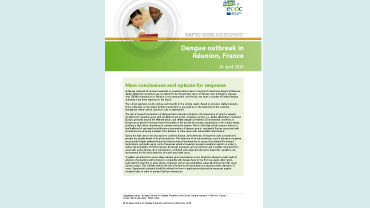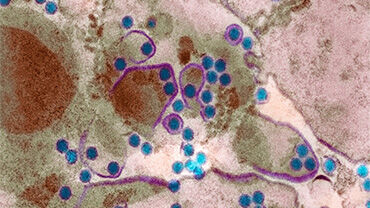Rapid risk assessment: Dengue outbreak in Réunion, France
This update of the risk assessment published on 16 April 2018 was triggered by the unusual size and duration of the current dengue fever outbreak driven by Ae. albopictus, a mosquito vector present in Réunion and widely distributed in the southern part of EU.
Executive Summary
Since the beginning of 2018 and as of 24 June, 5 747 autochthonous cases of dengue have been reported in Réunion. Dengue virus (DENV) transmission in this island is not unexpected, but the current DENV-2 outbreak is of unusual size and duration. Aedes albopictus, the mosquito considered to be the vector of this outbreak, is also established and widely distributed in the southern part of European Union.
With the arrival of the southern-hemisphere winter in July, the outbreak is expected to weaken in intensity. However, no marked decline has been observed yet.
The probability of onward transmission of dengue fever in the EU and the European Economic Area (EEA) is associated with the importation of the virus carried by travellers. Since vector abundance in the EU is sufficient to permit autochthonous transmission of dengue virus, there is a risk for local outbreaks to develop.
Options for response
As no vaccines or prophylactic drugs are available, dengue fever prevention consists mainly on protection against mosquito bites. Aedes mosquitoes have a diurnal biting pattern, both indoors and outdoors, therefore measures should be applied all day long, and especially during the hours of highest mosquito activity (mid-morning, late afternoon to sunset). Other measures include the use of mosquito repellent in accordance with the instructions indicated on the product label, wearing long-sleeved shirts and long trousers, and using insecticide-treated mosquito bed nets. These actions can reduce the probability of importation of the virus into receptive areas of the EU/EEA.
Travellers returning from areas where dengue virus transmission occurs should be advised to seek medical attention if presenting with symptoms compatible with dengue fever in the first two weeks after their return.
During the season of high vector activity, early detection of imported dengue cases is essential to prevent local transmission. The detection of an autochthonous case in receptive areas in the EU/EEA should trigger epidemiological and entomological investigations. Increased awareness among clinicians and travellers returning from areas with active dengue virus transmission, combined with adequate laboratory diagnostic capability, are instrumental for the early detection of travel-associated cases.
EU/EEA Member States should also consider applying safety measures to prevent the transmission of dengue virus through donations of substances of human origin (SoHO) from travellers returning from Réunion.
Download







